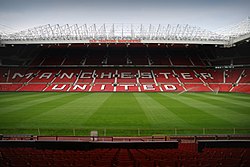Old Trafford
From Wikipedia, the free encyclopedia
This article is about the home of Manchester United F.C. For the cricket ground, see Old Trafford Cricket Ground. For other uses, see Old Trafford (disambiguation).
| Old Trafford | |
|---|---|
| Theatre of Dreams | |
 The Sir Alex Ferguson Stand (North Stand) seen from the South Stand |
|
| Location | Sir Matt Busby Way Old Trafford Trafford Greater Manchester |
| Coordinates | 53°27′47″N 2°17′29″WCoordinates: 53°27′47″N 2°17′29″W |
| Broke ground | 1909 |
| Opened | 19 February 1910 |
| Owner | Manchester United |
| Operator | Manchester United |
| Surface | Grass |
| Construction cost | £90,000 (1909) |
| Architect | Archibald Leitch (1909) |
| Capacity | 75,765[1] |
| Record attendance | 76,962 (Wolverhampton Wanderers vs Grimsby Town, 25 March 1939) |
| Field dimensions | 105 by 68 metres (114.8 yd × 74.4 yd)[1] |
| Tenants | |
| Manchester United (1910–present) | |
The ground, nicknamed the Theatre of Dreams by Bobby Charlton, has been United's permanent residence since 1910, with the exception of an eight-year absence from 1941 to 1949, following the bombing of the stadium during the Second World War. During this period, the club shared Maine Road with local rivals Manchester City. The ground underwent several expansions in the 1990s and 2000s, including the addition of extra tiers to the North, West and East Stands, which served to return the ground almost to its original capacity of 80,000. Future expansion is likely to involve the addition of a second tier to the South Stand, which would raise the capacity to over 90,000. The stadium's record attendance was recorded in 1939, when 76,962 spectators watched the FA Cup semi-final between Wolverhampton Wanderers and Grimsby Town.
The ground has frequently hosted FA Cup semi-final matches as a neutral venue and several England international fixtures while the new Wembley Stadium was under construction. It also hosted matches at the 1966 FIFA World Cup and UEFA Euro 1996, as well as the 2003 UEFA Champions League Final. Aside from football-related uses, Old Trafford has hosted rugby league's Super League Grand Final since the league's adoption of playoffs in 1998 and the final of the 2000 Rugby League World Cup. The stadium hosted football matches during the 2012 Summer Olympics, including women's international football for the first time in its history.



0 Response to "Old Trafford"
Posting Komentar